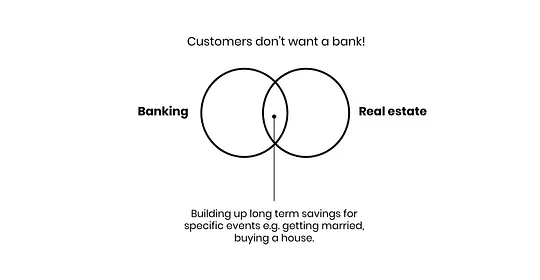Personal Financial Management: The Jobs to be Done
Customers don’t want a bank. Redefine your market using Jobs to be Done thinking.
Top 5 things you’ll get from reading this report:
- Discover what the next killer proposition looks like within the UK PFM Market
- Explore the trajectory of the market, and learn where it’s headed
- How to align your proposition to what customers really want
- Learn how Jobs to be Done can help identify the “opportunity space” in the fast-moving world of fintech
- Recognise the importance of speaking to your customers – and how research doesn’t need to be dull
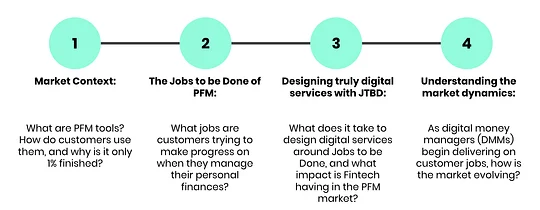
Key findings
Open banking and the integration of PFM features with digital banks created a market for DMMs. Growth will come from satisfying more customer jobs within a single end-to-end experience for customers.

A note on methodology
A qualitative & quantitative study of UK adults aged 18–65 with a smartphone and bank account.
13 in-depth remote interviews
30–40 minute one-to-one interviews with people from around the country and a variety of different age groups and income groups.

1049 nationally-representative quantitative interviews
The survey was designed using the Jobs to be Done uncovered in the qualitative phase. We used a trade-off technique called MaxDiff to collect the JTBD metrics. This means the scores are relative to each other rather than absolute scores from rating scales.
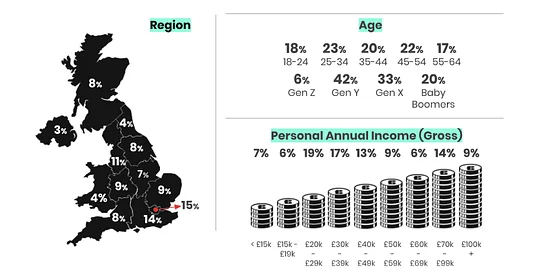
Market context
What is Personal Finance Management (PFM)?
PFM is a loosely defined term for talking about how people generally stay on top of their finances. Most of us (89% of the UK) try to manage our personal finances, but use a variety of tools to do so. This includes notebooks, spreadsheets, and now with the advent of fintech, Digital Money Managers (DMM). A DMM is an online or mobile app-based service that intelligently helps customers manage their money e.g. Yolt or Money Dashboard.
This report examines the jobs customers are trying to make progress on when using these PFM tools (both physical or digital). We take a closer look at DMMs later using user journeys from 11:FS Pulse.

Customers' financial lives are complex
Managing our personal finances is a complex process. Some people have unpredictable and variable income. Some have shared financial responsibilities. And some people are hard up and need to budget daily to ensure they stay in the black.
Life is unpredictable and how we spend our money can be impulsive and emotional. This makes it difficult to create the perfect system for a mass market audience, which might suggest why only 14% of the UK have tried a DMM. And interestingly, those that use DMMs are also more likely to use spreadsheets and notepads to stitch together their perfect system.
DMM users are more likely to use spreadsheets and notepads

DMMs are only 1% finished
DMMs’ focused approach to attacking the PFM market means there’s still a long way to go. Looking at the usage levels across the wider UK population, they are still very small players in the wider FS world. Given the complexities of people's’ personal financial lives, designing a digital money manager is going to be challenging. The current wave of fintechs have made a good start, however, most have focused on a thin slice of the wider set of Jobs to be Done involved in PFM.
Delivering a truly digital solution around an important customer job is a great strategy to quickly find product/market fit.
DMM usage in the UK

DMMs are largely being used by a certain type of customer: affluent Millennials

Where do DMMs go from here?
Whilst DMMs have got off to a great start they need to continue to grow. But how? Jobs to be Done is a great way to analyse and understand the market dynamics at play from a customer demand perspective.
It helps us understand customer motivations in relation to the products and services they use. Through identifying the jobs customers are trying to make progress on we can identify the market opportunity ahead. And when new services, like DMMs, enter the market the customer’s priorities change and the market dynamics shift.
It’s [DMM] still in its infancy. It’s still not as intuitive as I would like. I’m thinking Apple style, like move that there and that move there, easy. All done.
34 year old, single mum, freelancer
The Jobs to be Done of PFM.
Customers don’t want a bank. They want to live better with money
Digital banking is only 1% finished. DMMs are an important part of digital banking. This statement emphasises the huge opportunity to rethink the banking sector for the digital world – which DMMs have begun to do.
So how do we go about building the next 99%?
A big part of the solution is making the shift away from commodity products towards truly digital services. The focus here being on designing services around end-to-end customer journeys. To identify what these are and how we should prioritise them we apply Jobs to be Done thinking to the research and design process.
The result is an ability to design propositions customers love and spot disruptive moves in the market.
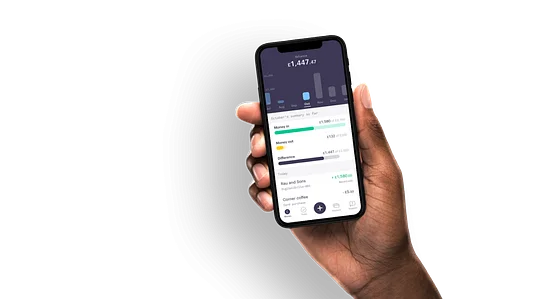
The 12 Jobs to be Done of personal finance management (PFM)
We identified 12 Jobs to be Done important to the customer in the domain of PFM.
These Jobs to be Done represent desired future states customers are trying to make progress towards.
To grow, DMMs need to ask 2 key questions:
1. Which of these jobs are most underserved by the market?
2. Which jobs do customers most want to make progress on?
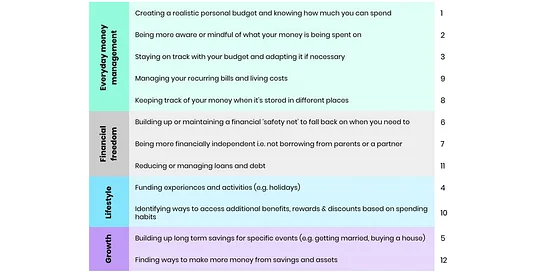
N.B. Numbers (x) related to position on the charts in the next two slides
Non-users of DMMs are looking to get the basics right.
Most non-DMM users are still trying to actively manage their personal finances. They are creating systems of their own stitching together spreadsheets, notebooks and using their bank’s mobile apps. We spoke to some people using jars and pinboards to help organise and visualise their money.
The most important and underserved jobs for this group are getting a better grip on their recurring monthly bills and building up a “safety net” of savings to fall back on. These are jobs DMMs can help customers achieve, so how do these priorities change once customers start using DMMs?
Opportunity exists when important jobs are difficult to get done, like:
Building up or maintaining a financial ‘safety net’ to fall back on when you need to (number 6 below).
DMMs can tap into this opportunity by helping customers make progress on this job by removing some of the constraints that make things difficult for customers.

Money management systems customers have adopted
When customers “hire” a DMM, the progress they want to make changes
Once customers begin using Digital Money Managers (DMMs) to help them manage their personal finances their priorities change. The extra control and awareness customers have from using these services means that they want to do more with their money.
This is a huge opportunity for DMMs to extend their product experience to help customers build up goal orientated long term savings and find more ways to make money from their savings and assets. Tapping into these new jobs will enable DMMs to build out new end-to-end customer journeys that unlock new customer value.
Two new jobs enter the opportunity space for DMM users.
The strongest opportunities are charted on the below matrix:
Building up long term savings for specific events (e.g. getting married, buying a house) (5).
The other opportunity is also related to helping the customer growing their money:
Finding ways to make more money from savings and assets (12).
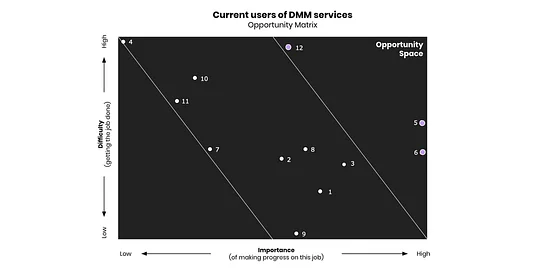
The Jobs to be Done analysis shows that these are the top opportunities for DMMs in the UK
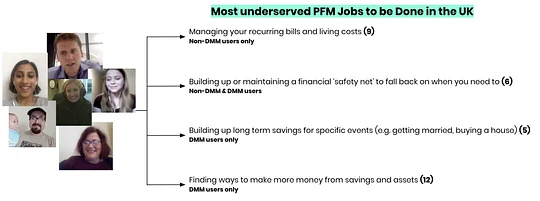
Manage your recurring bills and living costs
Customers are usually good at tracking major regular outgoings (e.g. rent, mortgage), but they often lose track of the multitude of smaller ones (buying lunch, coffee or going for a drink). Forgetting to account for a scheduled outgoing leaves customers with an inaccurate picture of their finances and often catches them off guard.
How to deliver on this job
- Deliver great UX so customers can easily see what’s coming out and when. Eliminating nasty surprises, especially with variable regular bills, was the top constraint for customers making progress on this job (23%).
- The second highest constraint (21%) was to help customers get a bird’s eye view of their finances. They know certain money has been ‘earmarked’ for future payments but it’s too difficult to track mentally especially those quarterly and annual bills.
- Customers want clarity, not just when something is coming out, but also what it is. This helps them understand how they’re balancing necessities and luxuries. Some of the brand icons and notifications challenger banks provide help customers with this.
- Customers calculate their regular outgoings manually. Assist them by automating this process as much as possible
Build up or maintain a financial “safety net”
Customers want to be independent and self-sufficient but struggle to build up a buffer to fall back on for emergency cover. For most, disposable income is low (the biggest barrier to having a safety net, 29% PFM users) and financial lives are messy and unpredictable. As a result, any accrued savings tend to cover non-emergency purchases.
How to deliver on this job
- Help customers overcome the difficulty of building a “safety net”, especially on low incomes. This is the top constraint for customers making progress on this job (25%).
- Add “positive friction” into the user experience to help boost self-control and not dip into savings. This was the second top constraint for customers (22%). Utilising behavioural design techniques can help enormously. For example, the UK government auto-enrol workers into a pension scheme, which has led to a huge increase in people paying into pensions.
- Help customers feel in control. Spending can get out of control, especially when unexpected costs arise.
- Covering unexpected costs usually means compromising future events e.g. holiday. Help customers avoid this trade-off.
Make more money from savings and assets
Customers who have sufficient capital (whether big or small) want to better leverage their savings and assets to grow its value. However, their lack of information (e.g. what are the best rates on savings accounts), expertise (e.g. how to invest based on my risk profile), and time to research impede them from being confident enough to take action.
How to deliver on this job
- This feels very much like uncharted and intimidating territory for customers, so provide an easy way to get started. Customers are quick to acknowledge their lack of expertise and this was a top constraint (27%), something Acorns in the US has had success with.
- Help customers discover the best way for them (could be different for everyone) to grow their money. A lack of information was another top constraint for customers (25%).
- Help customers evaluate their existing savings and investments and provide actionable advice to optimise it. In particular, customers want reassurances over the risk levels of their investments.
- Take a holistic view of the customer’s portfolio across different platforms for a true assessment of all savings and investments.
Building up long-term savings for specific events (e.g. getting married, buying a house)
Everyone has important life moments they want to fund, but saving for specific long term events can be daunting, and something often pushed aside for ‘another day’.
How to deliver on this job
- The biggest constraint for customers making progress on this job is trying to save on a tight budget (27%). Helping customers understand what they need to save and coaching them to optimise their spending and saving would be a big step forward for these customers.
- A lot of the time customers are saving for a specific life event like buying a house. Designing an experience that connects their savings to an emotional purpose in life will help them think twice about spending this money on other things, the second biggest constraint for customers (21%).
- Gamification elements can create a positive association with saving and help to keep customers on track. Rewarding good habits, making mundane tasks fun, or showing incremental progress generates positive feedback loops.
There is an untapped opportunity in creating “onward journeys”
Those customers already using DMMs are now more conscious of their financial position. They can exert more control over their spending and they are more mindful about paying off debt and putting money aside.
What these customers now struggle with are future events that are obscure or undefined. These events seem too far away and the targets too big to take action against.
The opportunity for DMMs is to create “onward journeys” for customers i.e. help customers use their money for the purpose it was saved for, like buying a house. See Planto as an example later in the report.
Getting this right, however, means helping the customer avoid dipping into this money when unexpected costs arise. Furthermore, this means creating more complex end-to-end customer journeys.
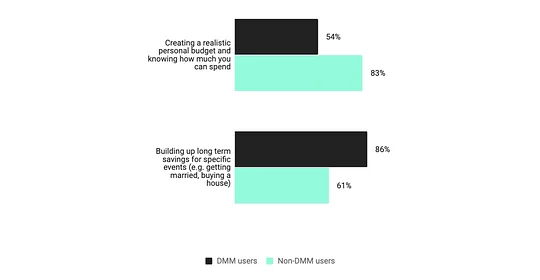
Designing truly digital services with JTBD
The anatomy of a truly digital fintech. Start with the customer job to design end-to-end experiences
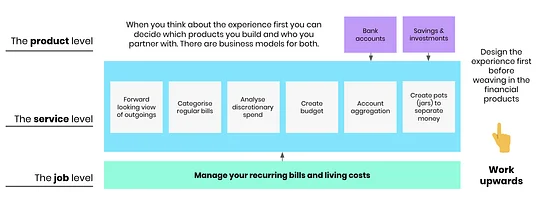
Yolt is a great example of using a Jobs to be Done mindset to deliver a great “service” based experience for its customers

Delivering end-to-end experiences involve stitching together multiple APIs
Open banking in the UK has allowed DMMs to more effectively deliver digital services that help customers make progress on these jobs:
- Keeping track of your money when it’s stored in different places.
- Being more aware or mindful of what your money is being spent on.
By aggregating their accounts from multiple banks, customers can now better keep track of their money and be mindful of where it’s being spent.
But not all the Jobs to be Done we tested are being serviced in this way. The next two slides map the Jobs to be Done to the DMMs we tested in this research.

Which DMMs cover these Jobs to be Done
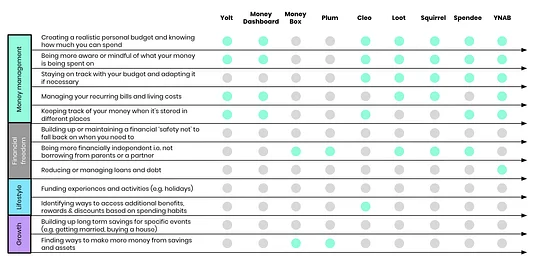
Which DMMs cover these Jobs to be Done (Cont.)
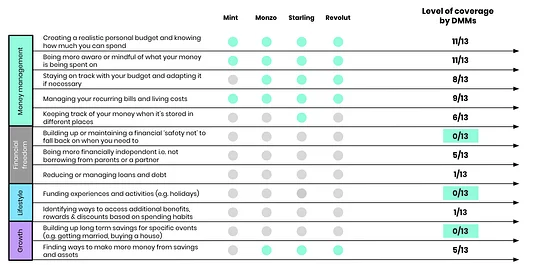
Digital services should focus on the desired “end state” of the job
Among the DMMs we included in this research there are none that specifically focus on three of the Jobs to be Done we identified in our PFM research (right).
There are many DMMs that help customers save and grow their money. There is a Job to be Done specifically for that: Finding ways to make more money from savings and assets.
Those DMMs that help customers grow their money could also be hired for the jobs on the right. However, these Jobs to be Done have a specific desired state associated with the “process of saving or investing”. That is to say that saving or investing is not the customer's end state.
Delivering on these Jobs to be Done would mean creating digital end-to-end experiences we have not seen so far in the UK.
3 Jobs to be Done completely un-served by UK DMMs
- Building up or maintaining a financial ‘safety net’ to fall back on when you need to.
- Funding experiences and activities e.g. holidays.
- Building up long term savings for specific events e.g. getting married, buying a house.
Planto (a Hong Kong fintech) is a good example of a DMM delivering onward journeys for customers
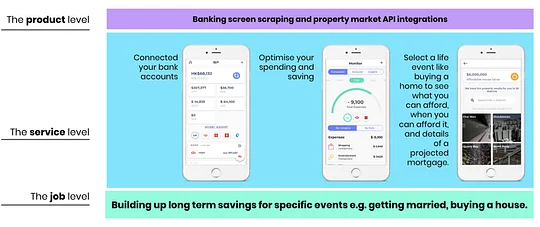
Understanding the market dynamics
Identifying growth for DMMs
The customer Jobs to be Done research identifies the jobs customers are trying to make progress on. The market analysis, using tools like 11:FS Pulse, show us what DMMs currently offer customers and the types of digital experiences they have designed.
Now we bring these two analyses together to identify the growth space for DMMs and how this market will evolve.
How we analyse the market (see the below matrix).
Hygiene Factors
The market is providing services for these jobs and customers feel well served. DMMs have to deliver on these jobs to stay competitive.
The Current DMM Battlefield
This is where the current DMMs are servicing the underserved customer jobs that exist in the market today.
Growth Opportunity
These jobs are important to customers but difficult for them to make progress on. The market is not servicing these jobs so they represent high growth opportunities for DMMs to evolve their propositions.
De-prioritise
These jobs are not being serviced by the current providers in the market and they are not a priority for customers. As the market changes these may move into one of the other quadrants in the future.
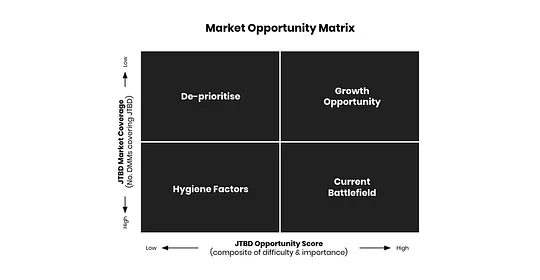
DMMs are competing to help customers make progress on budgeting & managing bills (see the below matrix).
Hygiene Factors
- Keeping track of your money when it’s stored in different places (8)
- Being more aware or mindful of what your money is being spent on (2)
The Current DMM Battlefield
- Staying on track with your budget and adapting it if necessary (3)
- Managing your recurring bills and living costs (9)
- Creating a realistic personal budget and knowing how much you can spend (1)
In transition (in between growth and current battlefield)
- Finding ways to make more money from savings and assets (12)
Growth Opportunity
- Building up long term savings for specific events e.g. getting married, buying a house (5)
- Building up or maintaining a financial ‘safety net’ to fall back on when you need to (6)
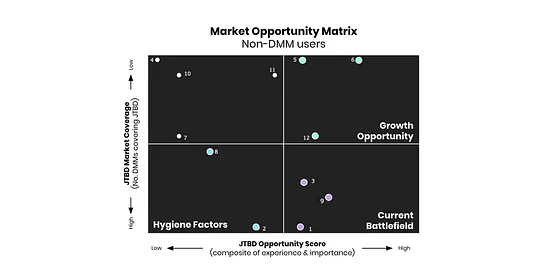
As customers hire DMMs, 'battlefield' jobs become the new status quo
Hygiene Factors
- Keeping track of your money when it’s stored in different places (8)
- Being more aware or mindful of what your money is being spent on (2)
- Managing your recurring bills and living costs (9)
- Creating a realistic personal budget and knowing how much you can spend (1)
The Current DMM Battlefield
- Staying on track with your budget and adapting it if necessary (3)
In transition (in between growth and current battlefield)
- Finding ways to make more money from savings and assets (12)
Growth Opportunity
- Building up long term savings for specific events e.g. getting married, buying a house (5)
- Building up or maintaining a financial ‘safety net’ to fall back on when you need to (6)
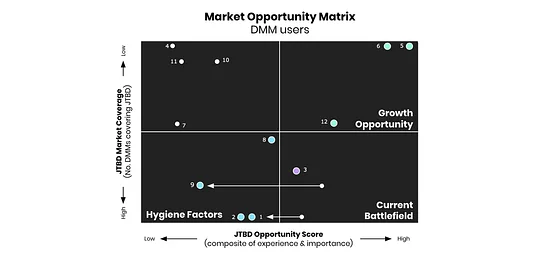
To evolve their propositions DMMs need to deliver on the jobs in the growth space
Whilst some DMMs offer ways to save and grow their money, none offer an end-to-end experience for doing these Jobs to be Done placed in the growth opportunity quadrant:
- Building up long term savings for specific events e.g. getting married, buying a house (5)
- Building up or maintaining a financial ‘safety net’ to fall back on when you need to (6)
These jobs have the highest customer opportunity score which means they ranked the most important and the most difficult to get done.

Don’t be bound by your category. Redefine the market
The key message to take away from this report is that customers don’t want rigid products. They want truly digital services that help them make progress on those important jobs in their life.
By adopting jobs thinking you can design services customers will love. This will likely mean stitching together various APIs to deliver on that end-to-end experience. The more you focus on delivering services around your customers’ jobs, the more you’ll redefine your category. Customers don’t think about the things they buy in terms of traditional industry categories so don’t be bound by them.
